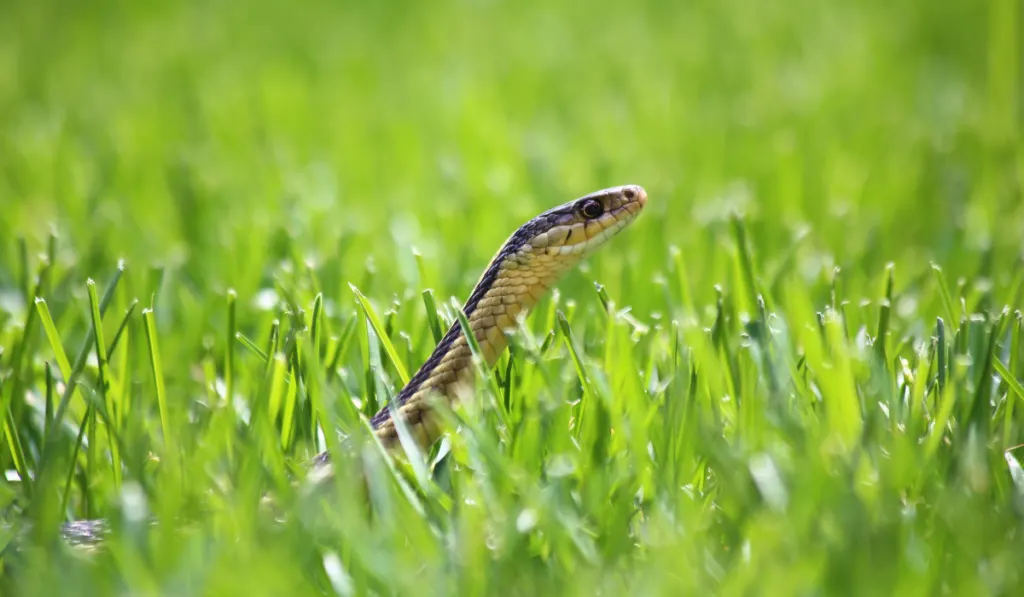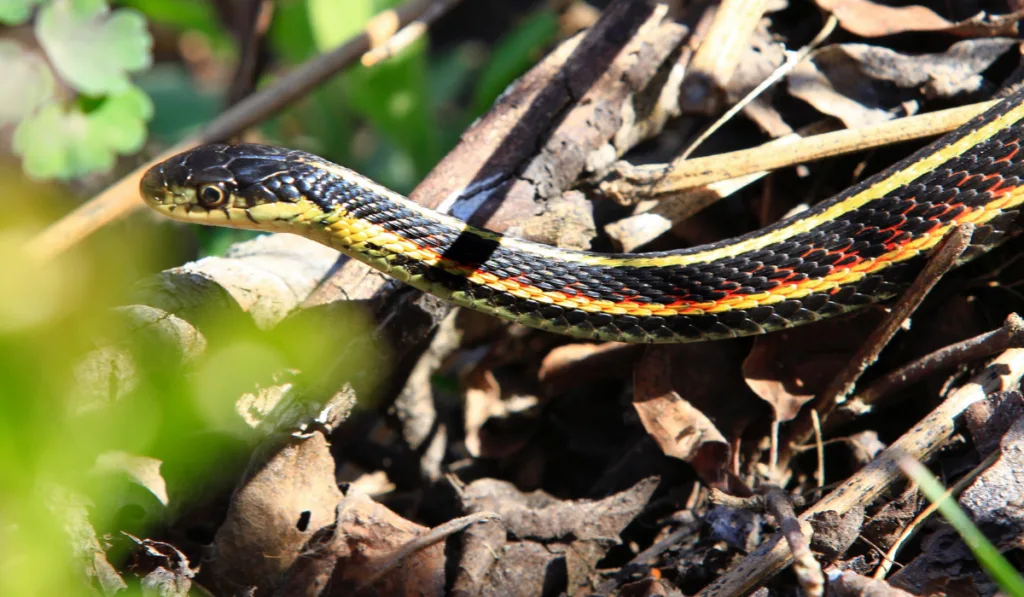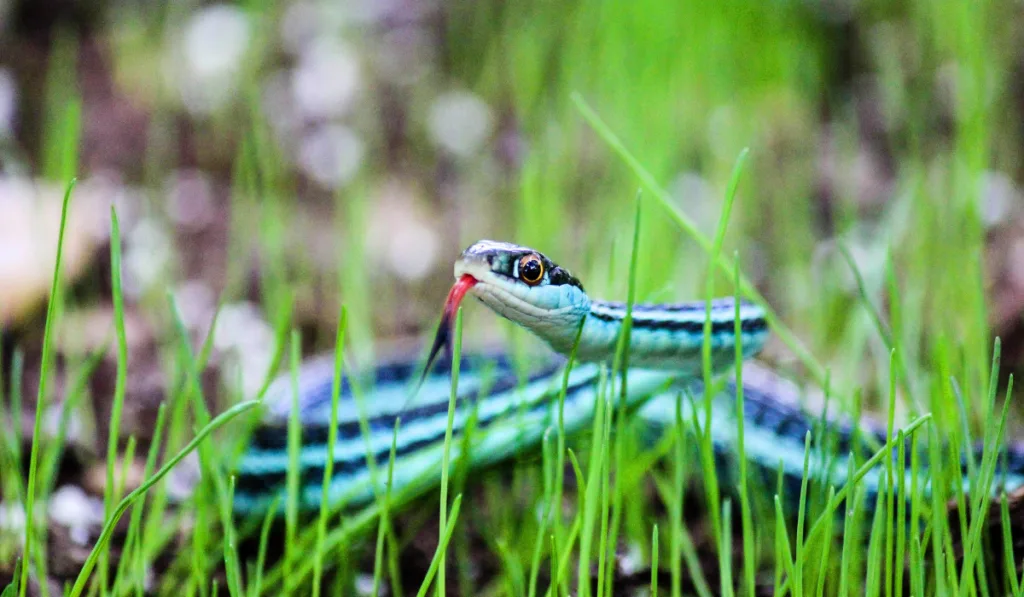Garter snakes can be encountered in woodlands, meadows, and near water sources across the North American continent. It is a harmless, small- to medium-sized snake that is adaptable to different habitats and is Massachusetts’s state reptile.
If your garden runs through a wetland or has a stream or pond on it, you may find a garter snake around.
Garter snakes, like many snakes, have teeth and jaws, which means that they can bite. Most snakes will attempt to get away before they resort to biting, and it is best to leave them to it. If they feel trapped, garter snakes will bite to defend themselves.

Garter snakes are among the most common snakes in North America and are often kept as pets. Garter snakes do not go looking for people to bite.
They are carnivores and will consume a wide variety of prey, including slugs, insects, earthworms, leeches, lizards, frogs, and their eggs, minnows, and rodents.
Therefore, they can be a natural form of pest control in your garden, and you should treat them with respect. The experts agree that they are good to have around.
Table of Contents
How To Avoid Being Bitten By A Garter Snake
The best way not to get a garter snake bite is to leave it alone. Do not try to kill it or hurt it or pick it up. People provoke most bites.
Garter snakes are active in the day, so encounters with humans are possible. They tend to hide in shrubs, vines, and other vegetation because they have many predators, including hawks, crows, foxes, and raccoons.
In the winter, they hibernate in large groups in dens and travel far to get to them. You should never disturb a hibernating animal because if it wakes up too soon, it could die.

Garter snakes are fast-moving and generally travel along the ground.
If you leave them to go about their business, you will not get bitten. If you try to pick one up or handle it, you significantly increase your chances of being bitten. Captive-bred garter snakes are often gentle because they are accustomed to being handled.
When they feel threatened, garter snakes give off a foul-smelling musk in addition to striking and biting. This is defensive behavior, not aggression.
If you corner a garter snake, it will put on a show to try and convince you to back off because it is afraid of you. Snakes generally don’t like to defend themselves by biting. They would far rather escape and hide away from the threat.
If you go out hiking in snake country, wear boots and long pants. Look where you put your hands and feet when climbing rocky outcrops, gathering firewood, or collecting berries.
Never walk barefoot in the dark. If you step on a snake by mistake, you could get bitten.
If you keep garter snakes as pets and take them from the wild, you shouldn’t have done that and may well get bitten when handling them.
It is better to buy captive-bred snakes to keep as pets because they are less likely to bite and have never been wild.
Are Garter Snakes Venomous?
For a long time, garter snakes were believed to be nonvenomous, but studies in the previous decade revealed they have a mild neurotoxic venom. This venom is not dangerous to humans who cannot be seriously killed or injured by it.
The amounts of venom they produce are small, and it is designed to stun their prey.
They also don’t have fangs at the front of their mouths to effectively deliver the venom. Garter snakes have enlarged teeth toward the back of the mouth, so they would have to chew on you for quite a while to envenomate you.
Their bite is likely only to cause minor itching and swelling at worst.

In 1985 it was reported that a thirteen-year-old who sustained a prolonged bite from an eastern garter snake was hospitalized after the bitten hand developed coolness, edema, and ecchymosis.
Ecchymosis is a discoloration of the skin due to bleeding underneath and is typically caused by bruising. Edema is a collection of fluid in body tissue.
Although there was involvement of his lymphatic system, his vital signs and laboratory tests came back normal, and he made a rapid recovery.
Cats and dogs may be tempted to play with or even hunt garter snakes they find In the garden, but they are much more dangerous to the snake than it is to them.
They are unlikely to sustain any serious effects from a bite.
If they take the snake in their mouths and it musks in defense, this won’t harm them, but they may drool. You can wash the pet’s mouth out with clean water.
What To Do If A Garter Snake Bites You
Don’t panic! Being bitten by a garter snake does not usually constitute a medical emergency, and there is no need to rush off to the Emergency Room.
Depending on the bite’s duration and whether the snake decides to use its venom or not, garter snakes are capable of occasionally causing mild envenomation in humans.
However, a snake can choose not to use its venom when it bites you. This is commonly called a dry bite.
Many snakes like to conserve their venom for its intended use – catching and consuming prey. So even if a garter snake bites you, it may not envenomate you. If it does envenomate you, you are highly unlikely to suffer severe injury or death.
If you are not sure what kind of snake it was that bit you, or if the bite victim is a child, it is best to go to the ER.
If a garter snake bites you, wash the wound with soap and water to prevent bacteria from entering the body. You may want to use some disinfectant if you have it.
It is improbable that you will require antibiotics as the wound is usually tiny and clean. The teeth of a garter snake are small and unlikely to do much damage.
It is far worse to get bitten by a dog than by a garter snake. If you have some antibiotic ointment handy, you can apply some to the snake bite. Keep an eye open for signs of envenomation or infection.
In the unlikely event that the bite victim has an allergic reaction to the venom, this could constitute a medical emergency, particularly if it affects their breathing or they are showing signs of anaphylaxis.

While garter snake venom is not dangerous to humans, you can get tetanus which can be caused by a bacterial infection from any animal bite. It is not specific to garter snakes in particular or snakes in general.
Tetanus is a nasty illness that is well worth avoiding, and fortunately, this is a simple matter of getting vaccinated for it.
If you haven’t had a shot in the last ten years and are bitten by a garter snake, you may need to get a tetanus booster from the ER or your doctor within the next day or two.
If you can’t remember when last you had a booster, your doctor will advise if you need another one.
Conclusions
Garter snakes can bite but are unlikely to do so if you leave them be. Wild garter snakes should never be touched or handled, and you should respect them just like any other wild animal.
Pet garter snakes that are captive-bred may bite if handled roughly or cruelly but can have quite gentle temperaments. Garter snake bites are not dangerous to humans or cats, dogs, and other large animals.
Resources
- William K Hayes and Floyd E. Hayes’ Human Envenomation from the bite of the eastern garter snake, Thamnophis s. sirtalis.’
- https://www.sciencedirect.com/science/article/abs/pii/0041010185903769
- https://www.livescience.com/44072-garter-snake.html
- https://healthcare.utah.edu/the-scope/shows.php?shows=0_6c29xhf8
- D K Vest’ Envenomation following the bite of a wandering garter snake’ (Thamnophis elegans vagrans) https://pubmed.ncbi.nlm.nih.gov/7273669/
- https://www.webmd.com/first-aid/snakebite
- https://www.morrisanimalfoundation.org/article/close-encounters-slithering-kind-snake-bites-companion-animals
